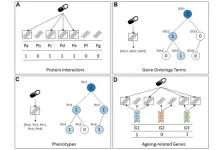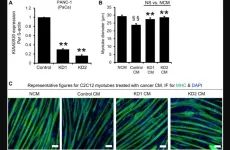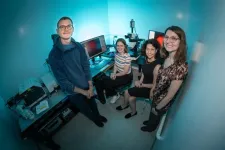(Press-News.org) Who lived at Machu Picchu at its height? A new study, published today in Science Advances, used ancient DNA to find out for the first time where workers buried more than 500 years ago came from within the lost Inca Empire.
Researchers, including Jason Nesbitt, associate professor of archaeology at Tulane University School of Liberal Arts, performed genetic testing on individuals buried at Machu Picchu in order to learn more about the people who lived and worked there.
Machu Picchu is a UNESCO World Heritage Site located in the Cusco region of Peru. It is one of the most well-known archaeological sites in the world and attracts hundreds of thousands of visitors every year. It was once part of a royal estate of the Inca Empire.
Like other royal estates, Machu Picchu was home not only to royalty and other elite members of Inca society, but also to attendants and workers, many of whom lived in the estate year-round. These residents did not necessarily come from the local area, though it is only in this study that researchers have been able to confirm, with DNA evidence, the diversity of their backgrounds. “It’s telling us, not about elites and royalty, but lower status people,” Nesbitt said. “These were burials of the retainer population.”
This DNA analysis works in much the same way that modern genetic ancestry kits work. The researchers compared the DNA of 34 individuals buried at Machu Picchu to that of individuals from other places around the Inca Empire as well as some modern genomes from South America to see how closely related they might be.
The results of the DNA analysis showed that the individuals had come from throughout the Inca Empire, some as far away as Amazonia. Few of them had shared DNA with each other, showing that they had been brought to Machu Picchu as individuals rather than as part of a family or community group.
“Now, of course, genetics doesn’t translate into ethnicity or anything like that,” said Nesbitt of the results, “but that shows that they have distinct origins within different parts of the Inca Empire.”
“The study does really reinforce a lot of other types of research that have been done at Machu Picchu and other Inca sites,” Nesbitt said. The DNA analysis supports historical documentation and archaeological studies of the artifacts found associated with the burials.
This study is part of a larger movement in archaeology to combine traditional archaeological techniques with new technologies and scientific analyses. This combination of fields leads to a more complete understanding of the discoveries made.
END
Ancient DNA reveals diverse community in “Lost City of the Incas”
2023-07-26
ELSE PRESS RELEASES FROM THIS DATE:
Essential cell death-regulating mechanisms important for recovery from SARS-CoV infection and skin injury discovered
2023-07-26
Programmed cell death, a fundamental biological process that facilitates the elimination of old, damaged, infected, and non-functional cells, plays a crucial role in maintaining the balance between health and disease in the human body. Research by the team of Dr Alessandro Annibaldi from the Center for Molecular Medicine Cologne (CMMC) at the University of Cologne has uncovered a novel mechanism of cell death regulation, shedding light on its significance during conditions such as SARS-CoV infection and skin injury. The study ‘Cleavage ...
DNA analysis offers new insights into diverse community at Machu Picchu
2023-07-26
New Haven, Conn. — A genetic analysis suggests that the servants and retainers who lived, worked, and died at Machu Picchu, the renowned 15th century Inca palace in southern Peru, were a diverse community representing many different ethnic groups from across the Inca empire.
The genomic data, described in a new study in Science Advances, is the first investigation of the genomic diversity of individuals buried at Machu Picchu and adjacent places around Cusco, the Inca capital. It builds upon previous archeological and bio-archaeological research, including a 2021 Yale-led study which found that Machu Picchu (AD 1420-1530) is older than was previously believed.
“The ...
Lost metabolic fitness of CAR NK cells is key mechanism of tumor resistance
2023-07-26
A new study led by researchers at The University of Texas MD Anderson Cancer Center discovered loss of metabolic fitness in chimeric antigen receptor (CAR) natural killer (NK) cells is a critical mechanism of resistance, with infused cells gradually losing the ability to compete with tumor cells for nutrients, leading to tumor relapse.
The study, published today in Science Advances, demonstrates that engineering CAR NK cells to express interleukin-15 (IL-15) enhances the cells’ metabolic fitness and provides a longer-lasting ...
Researchers develop machine learning models that could improve suicide-risk prediction among children
2023-07-26
A new study from UCLA Health researchers finds that the typical ways health systems store and track data on children receiving emergency care miss a sizable portion of those who are having self-injurious thoughts or behaviors. The researchers also found that several machine learning models they designed were significantly better at identifying those children at risk of self-harm.
Amid a nationwide youth mental health crisis, mental health providers are trying to improve their understanding of which children are at-risk of suicide or self-harm so providers can intervene earlier. However, health systems often ...
DOE announces $33 million to advance energy research across America
2023-07-26
WASHINGTON, D.C. — The U.S. Department of Energy (DOE) today announced $33 million to support 14 clean-energy research projects as part of a program to ensure the Department’s research funding is reaching pockets of the country that traditionally have received disproportionally low amounts of Federal scientific funding. The projects will cover a range of topics—including grid integration, renewable solar and wind energy, and advanced manufacturing. Today’s funding will help ensure all regions of the country share in the ownership of priority research that advances science and addresses energy ...
Predicting lifespan-extending chemical compounds for C. elegans with machine learning
2023-07-26
“We created datasets for predicting whether or not a compound extends the lifespan of C. elegans [...]”
BUFFALO, NY- July 26, 2023 – A new research paper was published in Aging (listed by MEDLINE/PubMed as "Aging (Albany NY)" and "Aging-US" by Web of Science) Volume 15, Issue 13, entitled, “Predicting lifespan-extending chemical compounds for C. elegans with machine learning and biologically interpretable features.”
Recently, there has been a growing interest in the development of pharmacological interventions targeting ...
KIAA0930: A cachexic phenotype inducer in cancer cells
2023-07-26
“We believe that KIAA0930 would be a novel cachexia therapeutic target.”
BUFFALO, NY- July 26, 2023 – A new research paper was published in Oncotarget's Volume 14 on July 20, 2023, entitled, “The uncharacterized transcript KIAA0930 confers a cachexic phenotype on cancer cells.”
Patients with cancer cachexia have a poor prognosis and impaired quality of life. Numerous studies using preclinical models have shown that inflammatory cytokines play an important role in the development of cancer cachexia; however, no clinical trial targeting cytokines has been successful. Therefore, ...
Lifespan of ageing science’s model organism driven by reproductive self-destruction
2023-07-26
The lifespan of a small roundworm that has been used as a key model organism in ageing research is limited by how it self-sacrifices to feed its young, finds a new study led by UCL researchers.
The authors of the new Nature Communications paper say their findings raise questions about how well insights from the Caenorhabditis elegans (C. elegans) worm can be translated to human ageing advances.
C. elegans is widely used as a laboratory animal, and has been central to ageing research for 40 years thanks to discoveries of genes that can be supressed to produce up to a tenfold increase in ...
A study outlines the optimal strategy for accelerating the energy transition in China
2023-07-26
China has set itself the goal of reaching its peak of carbon dioxide emissions in 2030 and thereafter to reduce emissions to reach carbon neutrality by 2060. To achieve this, it needs to increase photovoltaic (PV) and wind power to 10-15 petawatt hours (PWh) by 2060.
However, according to historical installation rates and a recent high-resolution energy-system-model and forecasts based on China's 14th Five-Year Energy Development Programme (CFEDP), the capacity of China for producing non-fossil-fuel energy will reach a maximum of only 9.5 PWh per year by 2060.
Now, an international study with the participation ...
How eavesdropping viruses battle it out to infect us
2023-07-26
Viruses, like movie villains, operate in one of two ways: chill or kill.
They can lay low, quietly infiltrating the body’s defenses, or go on the attack, exploding out of hiding and firing in all directions. Viral attacks are almost always suicide missions, ripping apart the cell that the virus has been depending on. The attack can only succeed if enough other healthy cells are around to infect. If the barrage of viral particles hits nothing, the virus cannot sustain itself. It doesn’t die, since viruses aren’t technically alive, but it ceases to function.
So for a virus, the key challenge is deciding when to flip from chill mode into kill mode.
Four years ago, Princeton ...


